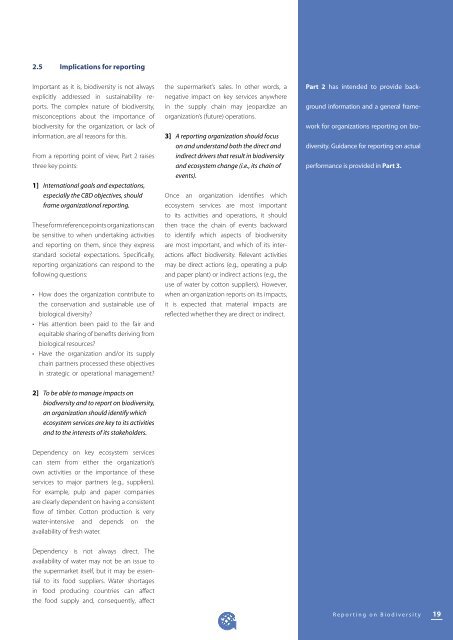Biodiversity - a GRI Reporting Resource - Global Reporting Initiative
Biodiversity - a GRI Reporting Resource - Global Reporting Initiative
Biodiversity - a GRI Reporting Resource - Global Reporting Initiative
You also want an ePaper? Increase the reach of your titles
YUMPU automatically turns print PDFs into web optimized ePapers that Google loves.
2.5 Implications for reporting<br />
Important as it is, biodiversity is not always<br />
explicitly addressed in sustainability reports.<br />
The complex nature of biodiversity,<br />
misconceptions about the importance of<br />
biodiversity for the organization, or lack of<br />
information, are all reasons for this.<br />
From a reporting point of view, Part 2 raises<br />
three key points:<br />
1] International goals and expectations,<br />
especially the CBD objectives, should<br />
frame organizational reporting.<br />
These form reference points organizations can<br />
be sensitive to when undertaking activities<br />
and reporting on them, since they express<br />
standard societal expectations. Specifically,<br />
reporting organizations can respond to the<br />
following questions:<br />
• How does the organization contribute to<br />
the conservation and sustainable use of<br />
biological diversity?<br />
• Has attention been paid to the fair and<br />
equitable sharing of benefits deriving from<br />
biological resources?<br />
• Have the organization and/or its supply<br />
chain partners processed these objectives<br />
in strategic or operational management?<br />
the supermarket’s sales. In other words, a<br />
negative impact on key services anywhere<br />
in the supply chain may jeopardize an<br />
organization’s (future) operations.<br />
3] A reporting organization should focus<br />
on and understand both the direct and<br />
indirect drivers that result in biodiversity<br />
and ecosystem change (i.e., its chain of<br />
events).<br />
Once an organization identifies which<br />
ecosystem services are most important<br />
to its activities and operations, it should<br />
then trace the chain of events backward<br />
to identify which aspects of biodiversity<br />
are most important, and which of its interactions<br />
affect biodiversity. Relevant activities<br />
may be direct actions (e.g., operating a pulp<br />
and paper plant) or indirect actions (e.g., the<br />
use of water by cotton suppliers). However,<br />
when an organization reports on its impacts,<br />
it is expected that material impacts are<br />
reflected whether they are direct or indirect.<br />
Part 2 has intended to provide background<br />
information and a general framework<br />
for organizations reporting on biodiversity.<br />
Guidance for reporting on actual<br />
performance is provided in Part 3.<br />
2] To be able to manage impacts on<br />
biodiversity and to report on biodiversity,<br />
an organization should identify which<br />
ecosystem services are key to its activities<br />
and to the interests of its stakeholders.<br />
Dependency on key ecosystem services<br />
can stem from either the organization’s<br />
own activities or the importance of these<br />
services to major partners (e.g., suppliers).<br />
For example, pulp and paper companies<br />
are clearly dependent on having a consistent<br />
flow of timber. Cotton production is very<br />
water-intensive and depends on the<br />
availability of fresh water.<br />
Dependency is not always direct. The<br />
availability of water may not be an issue to<br />
the supermarket itself, but it may be essential<br />
to its food suppliers. Water shortages<br />
in food producing countries can affect<br />
the food supply and, consequently, affect<br />
R e p o r t i n g o n B i o d i v e r s i t y<br />
19

















